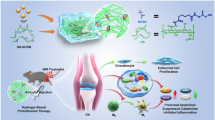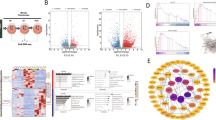Abstract
Osteoarthritis (OA) is a common chronic inflammatory joint disease characterized by cartilage degradation. p-Coumaric acid (PCA), a dietary phenolic compound, has exerted anti-inflammatory and anti-oxidative activities in various diseases. However, the effects of PCA on OA have not been reported. In the present study, we aimed to investigate the effects of PCA on interleukin-1β(IL-1β)-induced inflammatory responses and cellular senescence in rat chondrocytes. Our results revealed that PCA remarkably downregulated IL-1β-induced inflammatory factors such as COX2 and iNOS and cartilage-degrading enzymes like matrix metalloproteinases (MMP1, MMP3, and MMP13) and aggrecanases (ADAMTS4 and ADAMTS5) in chondrocytes. The IL-1β-induced degradation of cartilage matrix (collagen II and aggrecan) could also be suppressed by PCA. Besides, PCA treatment effectively inhibited the IL-1β-induced p16INK4a protein expression and SAβ-gal activities in vitro. Mechanism analysis showed that PCA suppressed IL-1β-induced activation of mitogen-activated protein kinase (MAPK) and nuclear factor-kappaB (NF-κB) pathways. In vivo, we also found that PCA could alleviate the development of OA in a rat model. Altogether, our findings implicate that p-coumaric acid attenuates IL-1β-induced inflammatory responses and cellular senescence via inhibition of the MAPK and NF-κB signaling pathway in chondrocytes, and p-coumaric acid may be a promising candidate for the treatment of osteoarthritis.






Similar content being viewed by others
References
Boehme, K.A., and B. Rolauffs. 2018. Onset and progression of human osteoarthritis-can growth factors, inflammatory cytokines, or differential miRNA expression concomitantly induce proliferation, ECM degradation, and inflammation in articular cartilage? International Journal of Molecular Sciences 19.
Sahin, S., S.A. Tuncel, K. Salimi, E. Bilgic, P. Korkusuz, and F. Korkusuz. 2018. Advanced injectable alternatives for osteoarthritis. Advances in Experimental Medicine and Biology 1077: 183–196.
Zhu, Z., J. Li, G. Ruan, G. Wang, C. Huang, and C. Ding. 2018. Investigational drugs for the treatment of osteoarthritis, an update on recent developments. Expert Opinion on Investigational Drugs 27: 881–900.
Hunter, D.J., and S. Bierma-Zeinstra. 2019. Osteoarthritis. Lancet. 393: 1745–1759.
Messina, O.D., M. Vidal Wilman, and L.F. Vidal Neira. 2019. Nutrition, osteoarthritis and cartilage metabolism. Aging Clinical and Experimental Research 31: 807–813.
Zhang, W., W.B. Robertson, J. Zhao, W. Chen, and J. Xu. 2019. Emerging Trend in the Pharmacotherapy of Osteoarthritis. Front Endocrinol (Lausanne) 10: 431.
Conaghan, P.G., A.D. Cook, J.A. Hamilton, and P.P. Tak. 2019. Therapeutic options for targeting inflammatory osteoarthritis pain. Nature Reviews Rheumatology 15: 355–363.
McMillen, B.A. 1985. Comparative chronic effects of buspirone or neuroleptics on rat brain dopaminergic neurotransmission. Journal of Neural Transmission 64: 1–12.
Poulet, B., and K.A. Staines. 2016. New developments in osteoarthritis and cartilage biology. Current Opinion in Pharmacology 28: 8–13.
Wang, T., and C. He. 2018. Pro-inflammatory cytokines: the link between obesity and osteoarthritis. Cytokine & Growth Factor Reviews 44: 38–50.
McCulloch, K., G.J. Litherland, and T.S. Rai. 2017. Cellular senescence in osteoarthritis pathology. Aging Cell 16: 210–218.
Price, J.S., J.G. Waters, C. Darrah, C. Pennington, D.R. Edwards, S.T. Donell, and I.M. Clark. 2002. The role of chondrocyte senescence in osteoarthritis. Aging Cell 1: 57–65.
Zhou, H.W., S.Q. Lou, and K. Zhang. 2004. Recovery of function in osteoarthritic chondrocytes induced by p16INK4a-specific siRNA in vitro. Rheumatology (Oxford) 43: 555–568.
Cha, H., S. Lee, J.H. Lee, and J.W. Park. 2018. Protective effects of p-coumaric acid against acetaminophen-induced hepatotoxicity in mice. Food and Chemical Toxicology 121: 131–139.
Pragasam, S.J., and M. Rasool. 2013. Dietary component p-coumaric acid suppresses monosodium urate crystal-induced inflammation in rats. Inflammation Research 62: 489–498.
Kheiry, M., M. Dianat, M. Badavi, S.A. Mard, and V. Bayati. 2019. p-Coumaric acid attenuates lipopolysaccharide-induced lung inflammation in rats by scavenging ROS production: an in vivo and in vitro study. Inflammation. 42: 1939–1950.
Neog, M.K., S. Joshua Pragasam, M. Krishnan, and M. Rasool. 2017. p-Coumaric acid, a dietary polyphenol ameliorates inflammation and curtails cartilage and bone erosion in the rheumatoid arthritis rat model. Biofactors. 43: 698–717.
Cheng, W., J. Jing, Z. Wang, D. Wu, and Y. Huang. 2017. Chondroprotective effects of ginsenoside Rg1 in human osteoarthritis chondrocytes and a rat model of anterior cruciate ligament transection. Nutrients 9.
Gerwin, N., A.M. Bendele, S. Glasson, and C.S. Carlson. 2010. The OARSI histopathology initiative - recommendations for histological assessments of osteoarthritis in the rat. Osteoarthritis and Cartilage 18 (Suppl 3): S24–S34.
Mabey, T., and S. Honsawek. 2015. Cytokines as biochemical markers for knee osteoarthritis. World Journal of Orthopedics 6: 95–105.
Amin, A.R., M. Dave, M. Attur, and S.B. Abramson. 2000. COX-2, NO, and cartilage damage and repair. Current Rheumatology Reports 2: 447–453.
Haseeb, A., and T.M. Haqqi. 2013. Immunopathogenesis of osteoarthritis. Clinical Immunology 146: 185–196.
Fan, Z., B. Bau, H. Yang, S. Soeder, and T. Aigner. 2005. Freshly isolated osteoarthritic chondrocytes are catabolically more active than normal chondrocytes, but less responsive to catabolic stimulation with interleukin-1beta. Arthritis and Rheumatism 52: 136–143.
Goldring, M.B., and S.R. Goldring. 2007. Osteoarthritis. Journal of Cellular Physiology 213: 626–634.
Troeberg, L., and H. Nagase. 1824. Proteases involved in cartilage matrix degradation in osteoarthritis. Biochimica et Biophysica Acta 2012: 133–145.
Meszaros, E., and C.J. Malemud. 2012. Prospects for treating osteoarthritis: enzyme-protein interactions regulating matrix metalloproteinase activity. Therapeutic Advances in Chronic Disease 3: 219–229.
Jenei-Lanzl, Z., A. Meurer, and F. Zaucke. 2019. Interleukin-1beta signaling in osteoarthritis - chondrocytes in focus. Cellular Signalling 53: 212–223.
Hou, A., P. Chen, H. Tang, H. Meng, X. Cheng, Y. Wang, Y. Zhang, and J. Peng. 2018. Cellular senescence in osteoarthritis and anti-aging strategies. Mechanisms of Ageing and Development 175: 83–87.
Jeon, O.H., C. Kim, R.M. Laberge, M. Demaria, S. Rathod, A.P. Vasserot, J.W. Chung, D.H. Kim, Y. Poon, N. David, D.J. Baker, J.M. van Deursen, J. Campisi, and J.H. Elisseeff. 2017. Local clearance of senescent cells attenuates the development of post-traumatic osteoarthritis and creates a pro-regenerative environment. Nature Medicine 23: 775–781.
Xu, M., E.W. Bradley, M.M. Weivoda, S.M. Hwang, T. Pirtskhalava, T. Decklever, G.L. Curran, M. Ogrodnik, D. Jurk, K.O. Johnson, V. Lowe, T. Tchkonia, J.J. Westendorf, et al. 2017. Transplanted senescent cells induce an osteoarthritis-like condition in mice. The Journals of Gerontology. Series A, Biological Sciences and Medical Sciences 72: 780–785.
Wu, Y., L. Chen, Y. Wang, W. Li, Y. Lin, D. Yu, L. Zhang, F. Li, and Z. Pan. 2015. Overexpression of Sirtuin 6 suppresses cellular senescence and NF-kappaB mediated inflammatory responses in osteoarthritis development. Scientific Reports 5: 17602.
Saklatvala, J. 2007. Inflammatory signaling in cartilage: MAPK and NF-kappaB pathways in chondrocytes and the use of inhibitors for research into pathogenesis and therapy of osteoarthritis. Current Drug Targets 8: 305–313.
Zhang, Y., T. Pizzute, and M. Pei. 2014. A review of crosstalk between MAPK and Wnt signals and its impact on cartilage regeneration. Cell and Tissue Research 358: 633–649.
Sondergaard, B.C., N. Schultz, S.H. Madsen, A.C. Bay-Jensen, M. Kassem, and M.A. Karsdal. 2010. MAPKs are essential upstream signaling pathways in proteolytic cartilage degradation--divergence in pathways leading to aggrecanase and MMP-mediated articular cartilage degradation. Osteoarthritis and Cartilage 18: 279–288.
Saito, T., and S. Tanaka. 2017. Molecular mechanisms underlying osteoarthritis development: Notch and NF-kappaB. Arthritis Research & Therapy 19: 94.
Rigoglou, S., and A.G. Papavassiliou. 2013. The NF-kappaB signalling pathway in osteoarthritis. The International Journal of Biochemistry & Cell Biology 45: 2580–2584.
Funding
This study was sponsored by the National Natural Science Foundation of China (Grant no.81772390) and the Fundamental Research Funds for the Central Universities (grant no. 2017KFYXJJ104).
Author information
Authors and Affiliations
Corresponding author
Ethics declarations
All experimental procedures were conducted in accordance with the guidelines approved by the Experimental Animal Ethics Committee of Tongji Medical College, Huazhong University of Science and Technology, Wuhan, China.
Conflict of interest
The authors declare that they have no conflicts of interest.
Additional information
Publisher’s Note
Springer Nature remains neutral with regard to jurisdictional claims in published maps and institutional affiliations.
Xiaojian Huang and Yingqian You contributed equally to this work.
Rights and permissions
About this article
Cite this article
Huang, X., You, Y., Xi, Y. et al. p-Coumaric Acid Attenuates IL-1β-Induced Inflammatory Responses and Cellular Senescence in Rat Chondrocytes. Inflammation 43, 619–628 (2020). https://doi.org/10.1007/s10753-019-01142-7
Published:
Issue Date:
DOI: https://doi.org/10.1007/s10753-019-01142-7




